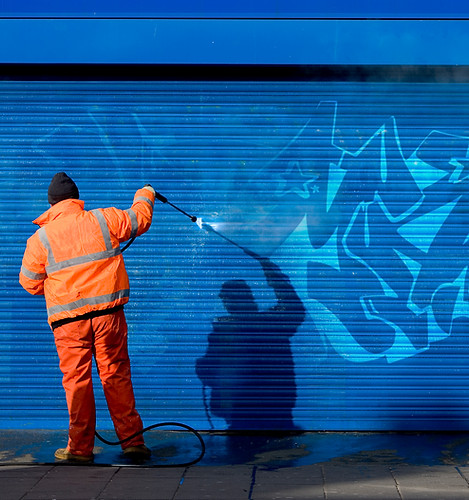
How Toronto's war on graffiti created iconic street art
An overview of how Toronto's lesiglation (and Ontario's in general) allowed the local street art scene to thrive
Ever since the dawn of time, art has been the ideal way for humans to express themselves. What once began as cave paintings with nothing more than berries and dirt on the wall would later become the height of realism and passion through the Renaissance era. This wasn't a hobby for the average man. Painting became a way for royalty to become immortals. If it wasn't a painting, it was a glorious statue, a tapestry, anything to show the world that the rich was on top.
But this is not that kind of story.
Toronto's art scene is anything but pretentious. While you may see a painting in the Art Gallery of Ontario priced at millions of dollars, there are tons of other pieces on walls and alleyways throughout the city that aren't getting noticed. Welcome to Toronto's Artery, a podcast about art in the heart of the city. On this show, you'll see art from the streets. Maybe you call it graffiti, maybe you think it's cluttering up the city. But one thing's for sure, these artists are creating what they want when they want.
Okay, so slight disclaimer. This podcast isn’t just about art in the downtown Toronto core. The artists that I’ve spoken to in this series aren’t limited to just working in one neighbourhood in the city, and, if you check out the map on the website, you’ll see that there is art all over the place.
You’ll also notice that there are a few different ways that artists refer to what they make. Graffiti, street art, community art, public art, these are all terms that artists may use when they’re speaking about creating art—whether it's with brushes or spraypaint, on walls outside. For the sake of simplicity, I’ll be referring to it as street art. But is there really a difference, well it depends on who you ask.
An article written by Jean Reichenbach in a 1991 issue of the University of Washington Magazine describes that graffiti walks the fine line between art and vandalism. Considering the time period for when this article was written, I wouldn’t be surprised if the influence of political turmoil from the ‘70s and ’80s was highly influential for the street art scene at the time. The article also goes on to say that people may turn to graffiti for a number of reasons: gang names, creative expression, or simply pushing the boundaries of what is and isn’t allowed in society are just a few reasons.
Honestly, I have yet to see a city that doesn’t have some form of street art. It’s pretty much inevitable, in my opinion, that at some point someone will take a can of Home Depot spray paint and just go to town on an alleyway.
Toronto isn’t an exception. In fact, when our most famous mayor, you know, the one who made international headlines for smoking crack, was elected in 2010, he made huge promises to clean up the graffiti in the city. Just one year after Mayor Rob Ford was elected, the Globe and Mail published an article titled “Rob Ford’s War on Graffiti.” According to the article, over 5,600 clean-up notices were issued by the city’s new team of ant-graffiti bylaw officers within a year and a half of Ford’s mayoral duties. Their solution was taking pressure washers to quite literally clean up the city.
Anti-graffiti legislation isn’t exactly new in Canada. In 2006, London Ontario became the first city in Canada to refuse the sale of both markers and spray paint to people under the age of 18 after 92 minors were arrested for making graffiti. According to CBC, some London city councillors weren’t impressed, and it isn’t hard to see why.
Art has never been without criticism, and you don’t have to be creating something violent and gorey to get in trouble for creating it. In 2013, in the midst of Rob Ford’s war on graffiti, there was another legal battle happening in Waterloo. According to CBC, the owner of a local Dairy Queen hired five graffiti artists to paint a mural on the side of the building. Soon after the art was completed, the city instructed the owner to paint over the mural: not because the city considered to be graffiti or vandalism, but because — according to the city's by-laws — the mural counted as an advertisement: and if you’re looking to advertise a business, you need a permit to avoid a fine.

"The woman" in Kensington Market
Image source: JR Harris via Unsplash
Perhaps one of the most prominent pieces of street art in the city is this one in Kensington Market. It's been around for at least a decade, and continually shows up in tourist photos. Often just referred to as "the woman," there is no text visible on the painting, meaning it's impossible to discern exactly what the painting is called. It is unknown who painted it.
It’s impossible to say just how much of the street art in Toronto has been made with the city’s permission. But then again, if a piece adds joy to a community, does it really matter how it got there in the first place? Believe it or not, Rob Ford’s war on graffiti was met with mixed results in 2012, despite the fact that the city also teamed up with an app called SeeClickFix, where people can take photos of the alleged illegal graffiti and report its location to bylaw.
But a key moment in this so-called war happened in 2013, when the city announced a brand new program called StreetARToronto.
Many of the artists I interviewed for this series mentioned this program as a huge contributor to their careers in the arts. The program was just simple and yet radical enough to get everyone’s attention. Instead of getting on the ground and blasting art with power washers, the city was now paying to add art to city walls. According to an article from the Toronto Observer, the goal of the campaign was to fund public art projects based on the logic that if someone’s getting paid to create art in a certain area, then they’re less like to create graffiti.
So what’s really the difference between street art as graffiti versus street art as a city-commissioned mural? What happens if you see a gorgeous mural, but it wasn’t done under the city’s specific regulations? Some may argue that adding a bureaucratic element means that you’re accepting the city’s money to paint on the condition that they could potentially censor your mural idea. What happens if you’re making art and you get a permit for the wall, but don’t get a permit for the sidewalk you’re standing on? Other people may also argue that on the other hand, the arts are almost always seriously underfunded, so any program providing grants to create something beautiful in your neighbourhood can make people feel proud of where they live.
On this podcast, you’ll hear different artists talk about what the city could do to support them more. Many of them said that having the ability to be financially compensated is important to them - after all, how can you focus on creating great art when you’re too busy worrying about your bills?
You could ask a hundred people about street are and probably get a hundred different opinions. But if you think Toronto’s art scene is limited to just Kensington Market and Graffiti Alley, you might be missing out. Next time you’re out and about, take the long walk around. Peer down different alleyways or see what’s painted on the back side of a community centre. Whether you call it street art, public art, graffiti, or murals, they’re everywhere in the city, and often in the places you least expect them. That’s what this podcast is all about: this is Toronto’s Artery.
